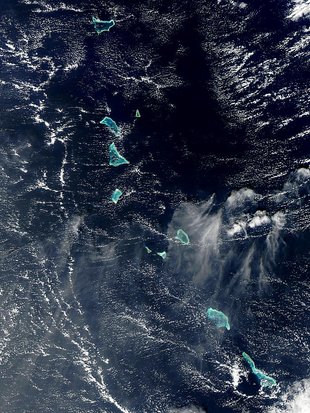Geography of Kiribati
|
|
Kr-map.png
Map of Kiribati
This article describes the geography of Kiribati.
Kiribati (pronounced "keer-ih-bahs") consists of 32 atolls and one island scattered over all four hemispheres in an expanse of ocean equivalent in size to the continental United States.
The islands lie roughly halfway between Hawaii and Australia in the Micronesian region of the South Pacific. The three main groupings are the Gilbert Islands, Phoenix Islands, and Line Islands.
On 1 January 1995 Kiribati moved the International Date Line to include its easternmost islands and make it the same day throughout the country.
Kiribati contains Kiritimati (Christmas Island), the largest coral atoll in the world, and Banaba (Ocean Island), one of the three great phosphate rock islands in the Pacific.
Most of the land is less than two meters above sea level. A 1989 United Nations report identified Kiribati as one of the countries that would completely disappear in the 21st century if steps were not taken to address global climate change. In mid-1999 it was announced that two uninhabited coral reefs had sunk beneath the sea.
Owing to a population growth rate of more than 2% and the overcrowding around the capital, a program of migration was begun in 1989 to move nearly 5,000 inhabitants to outlying atolls, mainly in the Line Islands. A further program of resettlement to the Phoenix Islands was begun in 1995.
Statistics
- Location
- Oceania, group of islands in the Pacific Ocean, straddling the equator, about one-half of the way from Hawaii to Australia; note - on 1 January 1995, Kiribati unilaterally moved the International Date Line from the middle of the country to include its easternmost islands and make it the same day throughout the country
- Geographic coordinates
- Template:Coor dm
- Map references
- Oceania
- Area
-
- Total: 717 km²
- Land: 717 km²
- Water: 0 km²
- Note: includes three island groups - Gilbert Islands, Line Islands, Phoenix Islands
- Area - comparative
- Four times the size of Washington, DC
- Land boundaries
- 0 km
- Coastline
- 1,143 km
- Maritime claims
-
- Exclusive economic zone: 200 nm
- Territorial sea: 12 nm
- Climate
- Tropical; marine, hot and humid, moderated by trade winds
- Terrain
- Mostly low-lying coral atolls surrounded by extensive reefs
- Elevation extremes
-
- Lowest point: Pacific Ocean 0 m
- Highest point: unnamed location on Banaba 81 m
- Natural resources
- Phosphate (production discontinued in 1979)
- Land use
-
- Arable land: 0%
- Permanent crops: 51%
- Permanent pastures: 0%
- Forests and woodland: 3%
- Other: 46% (1993 est.)
- Irrigated land
- NA km²
- Natural hazards
- Typhoons can occur any time, but usually November to March; occasional tornadoes; low-level of some of the islands make them very sensitive to sea-level rise
- Environment - current issues
- Heavy pollution in lagoon of south Tarawa atoll due to heavy migration mixed with traditional practices such as lagoon latrines and open-pit dumping; ground water at risk
- Environment - international agreements
-
- Party to: Biodiversity, Climate Change, Desertification, Endangered Species, Law of the Sea, Marine Dumping, Ozone Layer Protection
- Signed, but not ratified: None of the selected agreements
- Geography - note
- 20 of the 33 islands are inhabited; Banaba (Ocean Island) in Kiribati is one of the three great phosphate rock islands in the Pacific Ocean - the others are Makatea in French Polynesia, and Nauru

